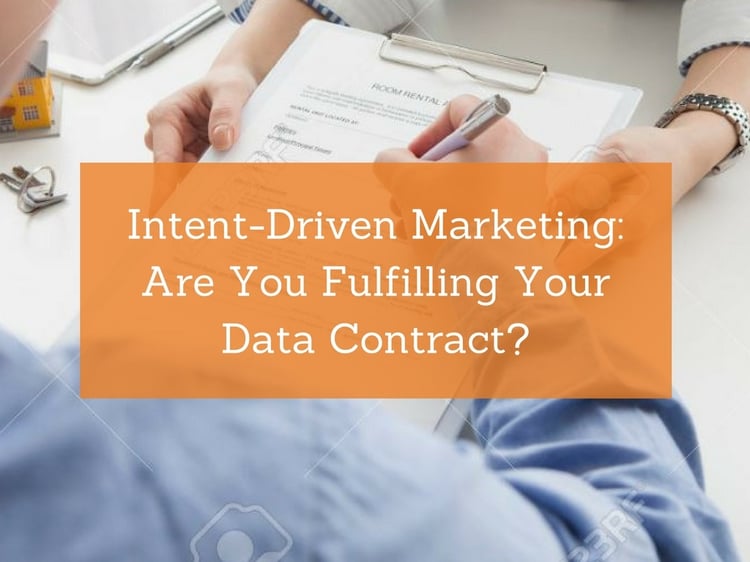
All marketers strive to establish a connection with their prospects and customers, but it takes a thorough understanding of what people actually want before a business can ever truly hope to provide real value to consumers. And they gain that understanding by accessing and using consumer data. Data has given companies every opportunity to create individualized marketing communications that encourage consumers to become brand advocates, but there’s more to data utilization than gathering consumer information and pushing out sales and ads. As next-gen marketers, you must uphold your end of the new “data contract.”
What Is the Data Contract?
Today’s consumers are savvier than ever. They are fully aware of the power they hold in the marketplace, and they are ready to use that power to their advantage. Modern consumers come into the purchase decision with more information than ever before, and at any point along their buyer’s journey, they’re are eager to share their experience with a company via social media — whether it’s positive or negative.
Download our eBook to learn how to leverage your website visitors browsing beahvior to deliver individualized next-gen marketing.
Therefore, it stands to reason that businesses should do everything in their power to make the most of every customer touchpoint. But it’s important to approach this in the right way, and it must be done for the right reasons. Today’s customer simply wants to be understood and treated like an individual, rather than faceless audience segments. They want to engage with an organization that always goes above and beyond to make the customer experience special.
What’s more, shoppers are willing to pay a premium for these feelings — and that payment doesn’t just include paying more to ensure a great experience. They’re also very much aware of the data that’s collected in their every interaction with a retailer. Website cookies, loyalty cards and social media activity are just the tip of the iceberg when it comes to data transmission. Consumers are increasingly willing to provide marketers access to and use of personal consumer information, but this data exchange isn’t a one-way street.
Marketers must incorporate the various data points to create an individualized — valuable — customer experience. This data contract between consumers and marketers is vitally important to both sides of the equation. However, it’s the business side of the data contract that requires further investigation. Is your business holding up your end of the data contract after you’ve collected a consumer’s data?
What Do Consumers Expect?
When you consider the extent to which companies collect data about their customer base, consumers’ expectations are very reasonable. Mainly, consumers want value.
When most people think about value, they think about getting a good product for a fair price. Make no mistake, that’s absolutely part of the value equation for customers. But today’s consumer demands a little bit more than that. They don’t just want a good value in monetary terms. They also want to feel valued by their favorite companies.
This addition of value can and should start long before a sale is made. Companies that understand their customers know what they need to hear at any given point to nurture them along the path to purchase. The true key to identifying the most helpful marketing messages to send at the right time lies in intent marketing, which is centered around the analysis of the clues left by consumers as to what steps they might take next. For example, someone interested in learning about personal training might sign up for more information on a gym’s website. However, that individual probably isn’t ready to sign up for classes at that exact moment. The gym should understand this, and instead of moving into hard sell mode right away, the initial emails sent to that individual should be about general nutrition topics and the benefits of personal training. This is a friendlier introduction to the business, and it creates organic interest in the service being sold. In exchange, the prospective customer is happy about not being pressured, and he or she will be more actively engaged and get a better experience when they eventually do sign up for personal training. That enthusiasm will be repaid to the company when the individual raves about their experience to friends and family.
Of course, the more data you have on hand, the better equipped you’ll be to determine exactly what each customer wants as a response to their action. When you can figure that out, you’re ready to provide actual value to your customers. After all, the data contract isn’t a guessing game — you need the numbers on your side to show what people really want. According to Experian, only 31 percent of consumers like being messaged by companies to wish them a happy birthday. However, 53 percent of consumers are glad to receive a birthday message if there’s a discount code attached to the message. Knowing what your customers want — and being able to act on their desires — is essential to success in individualized marketing.
How to Anticipate Behavior and Deliver Individualized Marketing
If you were going someplace new and you didn’t know how to get there, you’d get directions before you left, right? The same sentiment applies to marketing in the data-driven era. If you want people to become loyal customers, you have to know the journey they’ll take along the way.
The absolute best way to get started with individualized marketing is to document the customer journey. But this isn’t the path you think people take. Instead, you’ll create the true path to purchase using all of the data you’ve collected about your audience. Every demographic, every different type of customer, every advertising medium must be considered and incorporated.
The more you can anticipate how people will respond to your marketing messages, the better you’ll be at delivering the right message at the right time. Laying out this entire customer roadmap not only helps you to pick up on the signs of intent data, but it’ll also help you put your data to its best possible use — making the customer experience as enjoyable as possible for all people. Remember, every member of your audience has a different idea of what makes your company special to them. It’s up to you to deliver that experience every time, in as many unique ways as necessary, so that you can reach people at an individual level.
It’s only at this point that the data contract becomes a two-way exchange of information and true value. Without the proper application of consumer data, the company cannot hope to deliver the individualized customer experience that people have come to expect. And if consumer expectations are not met, it becomes impossible for the business to collect the data necessary to optimize the customer experience. In a truly mutual data contract, both parties help each other, and both benefit from the arrangement.
Prioritizing Customer Engagement and Value
Technology makes it easier for businesses to collect data about consumers and apply that data in creative and unique marketing campaigns. Although this practice has increased customer expectations, it has also allowed companies to engage in individualized marketing that was unthinkable a decade ago. Carefully mapping the customer journey enables businesses to utilize intent marketing as they create a truly individualized marketing plan for each consumer, one that prioritizes engagement and value for each unique customer.


Lookalike Audiences Enhance customer acquisition by identifying high-potential prospects, boosting response rates, and lowering advertising costs.
Retargeting Postcards Double the performance of your direct mail retargeting.
Amplify Recognize unknown visitors who are actually customers. Add 20-40% to your ESP/CRM campaigns.
IQ Mail Retain customers with personalized, timely messages for those opting out of digital channels.







Comments